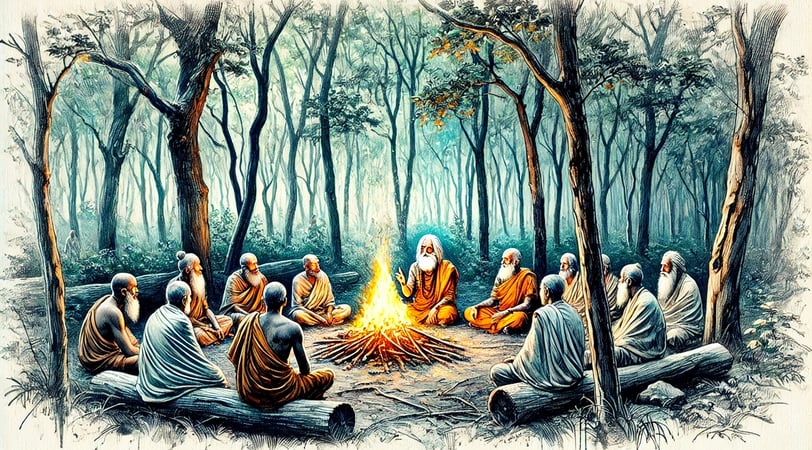1. Anukramanika Parva: The Gateway to the Mahabharata
The Anukramanika Parva of the Mahabharata serves as a prologue, outlining the contents and structure of the epic and setting the stage for the stories to follow by summarizing the principal themes and characters involved.
ADI PARVA
9/7/2024


In the tranquil setting of the Naimisha forest, where sages had gathered after a long twelve-year yagna, Ugrasrava, known as Sauti, the son of Romaharshana, arrived. Renowned for his mastery of the Puranas, Sauti approached the assembly of venerable Rishis with due respect and, observing all formal courtesies, sat down among them.
One of the Rishis, recognizing the arrival of such a learned Suta, respectfully inquired, “From where are you coming, lotus-eyed Sauti, and where have you been spending your time? Tell me, who asks you this, in detail.”
Sauti responded eloquently, “I have traveled across the sacred lands, listening to the diverse, sacred, and marvelous tales composed by Krishna Dwaipayana in his Mahabharata, recited by Vaisampayana at the sarpa yagna of the noble Rajarishi Janamejaya, son of Parikshit. Eager to share these stories, I have come into your presence.”
Welcoming him warmly, another sage asked, “O Sauti, we are keen to hear the tales you carry. Would you recount the sacred stories of the Puranas, filled with dharma and artha, or perhaps the deeds of enlightened Rishis and noble kings?”
Sauti, bowing to the wisdom of the gathering, began, “I pay my respects to the Primordial Being, Isana, to whom all make offerings, and who is adored by multitudes. He is both manifest and unmanifest, eternal, the creator of all, high and low. Today, I shall narrate the sacred thoughts of the illustrious Vyasa, whose tales of dharma, artha, kama, and moksha illuminate the minds of men like the sun dispels darkness.”
Delving into the Mahabharata, Sauti described the creation of the universe from the cosmic egg, the emergence of Brahma, Vishnu, and Shiva, and the creation of the world with its manifold complexities. He recounted the genealogies of gods, the lineages of kings, and the great deeds of heroes whose virtues and vices shaped the epic narrative of the Mahabharata.
He continued, “This Itihasa, composed by Vyasa, varies in both diction and division, has intricate and subtle meanings, logically combined and gleaned from the Vedas. It is a most holy work, reflecting the inmost meaning of the four Vedas.”
As Sauti spun the yarns of ancient tales, the sages listened, captivated by the narrative of the Kurukshetra War, the strategies employed, the divine interventions, and the philosophical discourses that emerged on the battlefield. The tales of Bhishma, the steadfastness of Kunti, the valor of Arjuna, and the wisdom of Vidura were recounted with reverence.
Describing the depth of the narrative, Sauti said, “This epic is a vast treasure of knowledge, spreading its branches wide and sheltering all who seek wisdom under its expansive canopy. It offers both light and shade, fruit and flower to those who come to it seeking knowledge.”
He spoke of the Bhagavad Gita as a discourse where Krishna reveals the profound duties of the Kshatriyas and the path to spiritual enlightenment, highlighting the dialogues between Krishna and Arjuna which form a crucial part of the epic.
Sauti's recitation painted a picture of a universe bound by the threads of dharma, where every action and every event had consequences that spanned generations, where divine and human realms intersected to create a tapestry rich with the colors of moral and ethical dilemmas.
Concluding, Sauti reverently said, “The Mahabharata, narrated by Vyasa and now by me, serves as a guide, a philosophical treatise that offers answers to the complex questions of life and duty. It is both history and allegory, instructing us on the right paths to pursue in the labyrinth of life.”
The sages, profoundly moved, thanked Sauti for his insights and the tales that not only entertained but also provided deep spiritual guidance. They reflected on the eternal truths woven into the fabric of the Mahabharata, recognizing its value as a sacred text that transcended time and space, offering lessons as relevant today as they were millennia ago.
